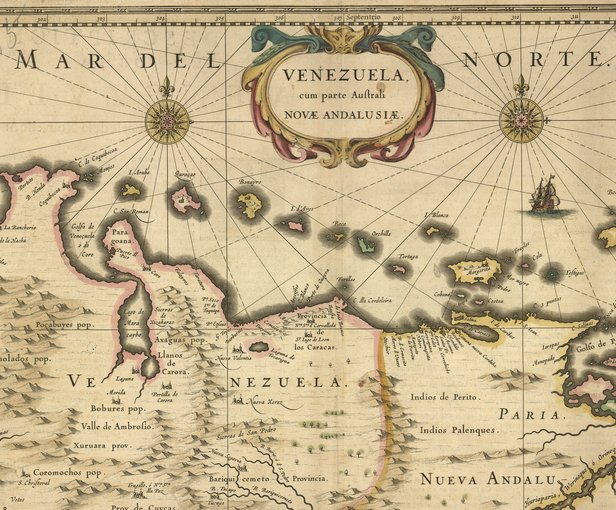
Western contact with Venezuela began in 1498 when Christopher Columbus reached the mouth of the Orinoco River. Several native peoples already inhabited the land—Arawaks and Caribs being the most well-known—however, shortly after “discovery” several European explorers landed and began surveying the area. One of the explorers, Amerigo Vespucci, named the territory Venezuela after Venice because some of the native structures were built on stilts above the river. German explorers had a major role in surveying the territory. Venezuela would eventually fall under the territory New Granada, under Spain’s dominion.
The map featured above was created in 1630 by a cartographer named Henricus Hondius. Originally from Belgium, his brother, his father, and he moved to Amsterdam and made a name for themselves making Mercator maps and atlases. This specific map features Venezuela and part of New Andalusia. Its creation demonstrates Europeans’ desire to chart Latin America and study the geography, an important factor in colonial control. Although on the cusp of the Colonial Crucible era (1600-1810), the map speaks more to the Encounter period (1492-1600). The Orinoco River, on the right side, is a significant geographic feature of the region because it provided the fertile farmland necessary for growing cacao and wheat. The surrounding Orinoco Basin is flat plains, called Llanos, which would later be important, before independence, when the llaneros dominated the land. Llaneros, similar to cowboys, would stand by the Spanish king Fernando VII when patriots started to challenge Spanish rule.
Works Cited
Chasteen, John Charles. Born in Blood and Fire. 4th edition. New York: W.W. Norton, 2016
Hondius, Henricus. “Venezuela Together with the Southern Part of New Andalusia.” WDL RSS, Library of Congress, 1 Jan. 1970, www.wdl.org/en/item/220/#q=colonial+venezuela.
McCoy, Jennifer L. “Venezuela.” Encyclopædia Britannica, Encyclopædia Britannica, Inc., 10 Mar. 2021, www.britannica.com/place/Venezuela.
“Venezuela.” The Columbia Encyclopedia, Paul Lagasse, and Columbia University, Columbia University Press, 8th edition, 2018. Credo Reference, http://0-search.credoreference.com.dewey2.library.denison.edu/content/entry/columency/venezuela/0?institutionId=4607. Accessed 13 Mar. 2021.
